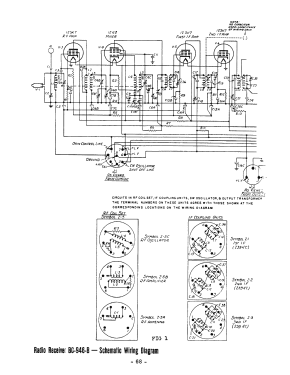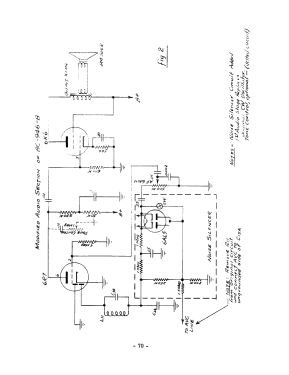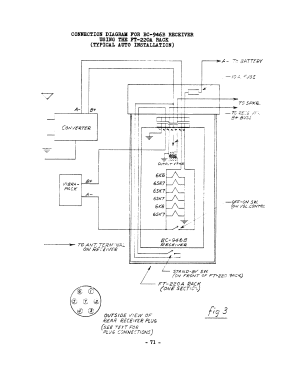- Pays
- Etats-Unis
- Fabricant / Marque
- MILITARY U.S. (different makers for same model)
- Année
- 1940 ?
- Catégorie
- Récepteur militaire
- Radiomuseum.org ID
- 330260
Cliquez sur la vignette du schéma pour le demander en tant que document gratuit.
- No. de tubes
- 6
- Lampes / Tubes
- Principe général
- Super hétérodyne avec étage HF; FI/IF 239 kHz
- Circuits accordés
- 6 Circuits MA (AM)
- Gammes d'ondes
- Bandes en notes
- Tension / type courant
- Piles (rechargeables ou/et sèches) / 24-28 Volt
- Haut-parleur
- - Pour casque ou amplificateur BF
- Matière
- Boitier métallique
- De Radiomuseum.org
- Modèle: BC-946-B - MILITARY U.S. different makers
- Forme
- Chassis (pour intégration dans meuble)
- Dimensions (LHP)
- 125 x 140 x 300 mm / 4.9 x 5.5 x 11.8 inch
- Remarques
-
The BC-946-B is the 520-1500 kHz version of the modular US Army Air Force SCR-274N series, each of which used an IF that was optimized for its RF coverage.
It was the most compact design possible while still allowing servicing and consisting of six metal octal tubes including an RF amp and two IF amps in a superheterodyne set with tuning that was designed to be within ½ percent throughout its range.
The Command sets were designed in the mid 1930s by the Aircraft Radio Corporation (ARC) shortly after metal octal tubes were introduced by RCA & GE. ARC had started as a spin-off of Radio Frequency Laboratories in Boonton NJ, and had initially developed radio range receivers for the Commerce Department starting in 1928. The sets were meticulously designed by the engineers headed by Dr. Frederick H. Drake, the Drake of Browning-Drake, who is credited with conceiving the idea of the modular system of superhet radios in 1934. The tuning controls for the radios are by way of a long mechanical cable to the cockpit, a system which was also used at the time for early automobile radio tuning and speedometers. ARC then received a preliminary and confidential contract from the Navy in 1937 for a “Type K” series of radios. An early version of the “K” used an as-yet-unmarked version of the 12A6 tube, important to the design as its 12 volt filament current requirement was the relatively minimal 150 mA and could thus be used directly in series with other standard 12 volt 150 mA receiving tubes. It is conceivable that RCA made the 12A6 at the request of ARC, as it is quite distinct from other octal audio output tubes then manufactured. Based on tests of the Type K series, the Navy adopted the sets in June 1939 for what became known as the ARA (receivers) and ATA (transmitters). The command sets produced for the Navy were so successful that the Army Air Force adopted them in 1940 as the SCR-274N series, with the “N” in that nomenclature reportedly a tip-of-the-hat to Navy.
- Poids net
- 4 kg / 8 lb 13 oz (8.811 lb)
- Littérature
- The Surplus Handbook - Receivers and Transmitters (schematic p. 89)
- Auteur
- Modèle crée par Rich Post. Voir les propositions de modification pour les contributeurs supplémentaires.
- D'autres Modèles
-
Vous pourrez trouver sous ce lien 408 modèles d'appareils, 360 avec des images et 215 avec des schémas.
Tous les appareils de MILITARY U.S. (different makers for same model)











